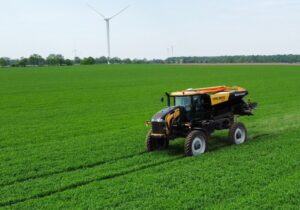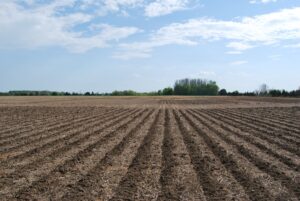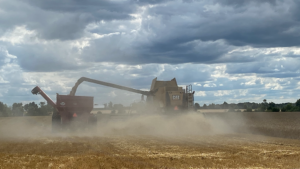Improving Nitrogen Management
FITTING PRACTICES TO THE ENVIRONMENT
Nutrient management is particularly important for nitrogen because nitrogen is critical in plant growth and because nitrogen, if managed incorrectly, can cause environmental damage.
Nitrogen use efficiency will decrease because of a variety of pathways of nitrogen loss. Under poor management and bad conditions, nitrogen losses can be high. In surface urea applications, for instance, if rainfall is delayed, nitrogen can be lost to the atmosphere through volatilization and immobilization. Under dry conditions, fertilizer can be stranded. While under wet conditions, nitrogen is lost mostly through denitrification and leaching. It’s important to note that these pathways of loss are all affected by the environment, and in turn, can have a negative impact on the environment.
“When we’re looking at nitrogen management, what we’re trying to do is reduce those pathways of loss and make sure that most of the nitrogen that’s leaving the field is actually being harvested by the crop and moving off through crop removal,” says Cynthia Grant, Agriculture and Agri-Food Canada, speaking at the Field Crops Production Efficiency Research Day. “The size and pathways of loss are strongly affected by the environmental conditions, by the soil characteristics and the weather conditions that are being experienced in that field.”
In the Prairies, most farmers band anhydrous ammonia in tight bands in the soil in the fall when the soil is still fairly cold. Scientists have been looking at how environmental conditions affect nitrogen losses in those fall applications. They looked at upper silt conditions (well-drained soil) and lower silt conditions (moist soil).
“They found that even if fertilizer was applied very early in the fall when the soil was still warm, they still got equivalent yields to the spring application, as long as the soil was well drained. This implies that nitrogen losses are very low in a well-drained soil,” says Grant. “On the other hand, on the moist soil, they get considerable loss and a large loss in yield if they put their fertilizer on early when the soil was warm. As they delayed the application later in the fall, they saw less loss and better performance. Again, the combination of warm conditions and moist conditions encouraged the microbial activity, the conversion of ammonium to nitrate, and the losses of nitrogen from the system.”
As far as Grant’s concerned, in the Prairies, banding at the time of seeding is an efficient base practice. It avoids over-winter and early spring losses. It reduces volatilization and immobilization losses by placing the fertilizer below the soil’s surface where it’s protected from volatilizing off to the atmosphere and below crop residue where it’s prevented from being tied up by the soil’s microbes. It can also reduce denitrification and leaching because banded ammonia or an ammonia-producing fertilizer slows the conversion of ammonium into nitrate. This lowers nitrate concentration in the solution and therefore reduces the risk of loss.
Except in the cases of winter wheat, fall rye, perennial forages and no-till fields, more than 70% of nitrogen is banded in the Prairies to improve efficiency. Losses did occur in situations where the bands were left unsealed, but it was still about a 1% loss of the nitrogen that was applied.
Volatilization losses can still occur with banded nitrogen applications under some conditions, says Grant. Low cation exchange soils saw higher losses, for instance. Also, in situations where bands were left unclosed and applications were followed by dry weather, greater losses occurred. When assessing the benefits of banding, Grant recommends considering soil, environment and placement debt first.
“By concentrating the N in a narrow band on the low cation exchange capacity soils you’re sort of swamping the ability of the soil to hold that N and you actually get higher losses than with a broadcast-incorporated application. This also happens on some of the tropical soils. So with a low CEC soil, the banding may not be as effective as we see it in some of the higher CEC soils. Also, losses can occur when the bands don’t properly seal.”
Split vs banded applications
It’s important to match the nitrogen supply with your crop’s demand, not just in terms of how much nitrogen you’re putting on, but also in terms of when the nitrogen is becoming available in proportion with when the plant is taking up that nitrogen. This will make sure that there isn’t nitrogen loitering in the soil that can later be lost to the atmosphere. The longer it’s in the soil before (or after) the plant can take it up, the more potential there is for loss.
Historically, farmers have used the practice of split applications to try to avoid nitrogen loss. As an advantage, it allows the rate of application to be changed if yields change, thereby minimizing investment costs wherever possible. Split applications are not popular in the Prairies due to their shorter, drier growing seasons. However, in areas with longer growing and lots of moisture, they’re a perfectly acceptable practice.
Split applications very rarely give higher yields than a banded application in a one-pass system, though. On the other hand, there are benefits in terms of risk management. You can delay the nitrogen without decreasing your crop yield, but you’re not likely to get higher crop yields because you’re delaying your nitrogen application. Drawbacks of split applications include the need for multiple passes, which increase labour, fuel consumption, and overall costs. There’s also the very serious risk of missing the very small window for the application.
“Producers, especially no-tillers, have very much bought into the concept of one pass application at the time of seeding,” says Grant. “The big discussion is ‘Should I do mid-row band or side-row band?’ not ‘Should I band?’” •








